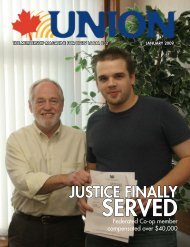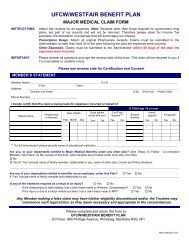Download - UFCW, Local 832
Download - UFCW, Local 832
Download - UFCW, Local 832
- No tags were found...
You also want an ePaper? Increase the reach of your titles
YUMPU automatically turns print PDFs into web optimized ePapers that Google loves.
THE MEMBERSHIP MAGAZINE FOR <strong>UFCW</strong> LOCAL <strong>832</strong> JULY 2008<strong>Local</strong> <strong>832</strong>partnerswith healthsciences centrefoundationto drive fora cure, and helpmanitobans.
secretary-treasurer CommentTHE STRUGGLE MUST CONTINUEAs secretary-treasurer of <strong>UFCW</strong> <strong>Local</strong><strong>832</strong>, I have a wide variety of duties andresponsibilities besides looking after thefinances and making sure the bills are paid. Iwork with President Ziegler when he negotiatesthe major contracts like Safeway, Westfair andMaple Leaf Brandon, as well as negotiatingseveral contracts on my own includingGranny’s Poultry, Springhill Farms and BrewersDistributors. I work with the full-time unionrepresentatives, our legal department to monitorthe progress of all of our grievances, work withthe various department directors to constantlyimprove our services, communications, andcollective bargaining strategies. I also sit as atrustee on most of the local’s jointly trusteedhealth and welfare benefit plans.One of the duties that I did not expect whenI was elected secretary-treasurer was to becomethe employer co-chair of our local office’s healthand safety committee. As an employer at a unionoffice, I guess I was guilty of taking healthand safety at our office for granted. I assumed(a mistake) that my experience as a memberworking at Sysco Foods had provided me with allI needed to know to perform this task effectively,because after all, Sysco was a large warehouseand this was just an office building. Boy was Iwrong.The union office on Portage Avenue hascompletely different health and safety issuesthan a warehouse, just as a packing househas completely different issues than a retailgrocery store or a call centre from a hospital ora potato plant from a group home, etc. I quicklylearned that I needed to learn about ergonomicworkstations, air quality issues and many otherconcerns related to my workplace.So I went back to school. I chose the best placeI could find to learn about health and safety andthat was the <strong>UFCW</strong> <strong>Local</strong> <strong>832</strong> Training Centre. Ibegan my education with the ABCs of health andsafety (an introductory course) and have beenapplying that education along with much ‘onthe job’ experience and the help of the expertson our staff. My own experiences have led me tolook more closely at the operation of the healthand safety committees in the workplaces that werepresent members and in some cases we havebeen disappointed in what we have found.We discovered that many of our committeesare not active and are not meeting regularly–even with the frequency required by health andsafety legislation. We uncovered that in somecases, management is appointing the labourcommittee members instead of the union doing itand that management co-chairs are controllingthe production and approval of meeting minutes.These minutes are not regularly being forwardedto the health and safety division as required.This means that some issues stay on the minutesfor months and months without ever beingaddressed or are simply removed before beingresolved.We discovered that site inspections in someplaces are rarely if ever being performedresulting in critical or potential hazards notbeing identified and accidents, or even deaths,not being prevented. In some cases, committeemembers are not being given the opportunityto get two full days of training each and everyyear as required by law. Many of our membersare simply not aware of their right to know, theirright to participate, or their right to refuse unsafeor unhealthy work.In Manitoba, we are lucky to have goodlegislation regarding health and safety (that weare constantly working to improve) and strongrights with respect to workplace protection, but ifwe don’t ensure that the laws are applied or if wedon’t exercise our rights, what good are they?<strong>UFCW</strong> and other unions in this country andacross the world are often given credit for beingleaders in the fight to protect workers fromexposure to dangerous hazards or conditions inthe workplace. We are often seen as the catalystfor adding new laws to protect workers andfor improving existing laws—not just by ourmembers, but also by government and, yes, evenby employers who are genuinely concerned forthe safety of their employees.If we are ever going to get a leg up in theongoing struggle to provide safe workplacesfor all working people, we are going to have toencourage our health and safety committees tobecome active and to educate themselves andtheir co-workers on their rights and protections.As a united group we are going to have to do abetter job of ensuring that each and every lawand regulation is enforced and stand together todemand our rights.I can think of no cause more noble ornecessary—for even if we save just one life orprevent just one critical injury, what a greatthing we have accomplished.Remember…an injury to one is an injury toall.Jeff TraegerSecretary Treasurer<strong>UFCW</strong> <strong>Local</strong> <strong>832</strong>2 UNION JULY 2008
THE MAGAZINE DISTRIBUTED TO THE MEMBERS OF <strong>UFCW</strong> LOCAL <strong>832</strong>JULY 2008DEPARTMENTS FEATURES OFFICESSHOP STEWARDSPage 8RETIREES’ CORNERPage 8WORKERS COMPENSATIONPage 9WESTFAIRPage 10PRODUCTIONPage 11HOSPITALITY, SERVICE & RETAILPage 12GRIEVANCE NEWSPage 13TRAINING CENTREPage 14UNION PARTNERS WITH HSCFPage 4WESTFAIR STEWARDS RECEIVENEGOTIATION TRAININGPage 5INTERNAL AUDIT CONDUCTEDLAST MONTHPage 5EMPLOYMENT INSURANCE: ITDOESN’T ADD UP FOR WOMENPage 6PRODUCTIVITY INCENTIVEBONUS ON BACK BURNERPage 7APPRECIATION NIGHT HELDIN BRANDONPage 7WINNIPEG1412 Portage AvenueWinnipeg, MB. R3G OV5786-50551-888-<strong>UFCW</strong>-<strong>832</strong>BRANDONUnit 1, 759 1st StreetBrandon, MB. R7A 2X5727-71311-800-552-1193THOMPSON90 Thompson DriveThompson, MB. R8N 1Y9778-71081-800-290-2608TRAINING CENTRE880 Portage AvenueWinnipeg, MB. R3G 0P1775-<strong>832</strong>91-877-775-<strong>832</strong>9PresidentRobert D. ZieglerSecretary-TreasurerJeff TraegerE-mail: ufcw@ufcw<strong>832</strong>.comWebsite: www.ufcw<strong>832</strong>.comUnion Representatives: Ron Allard, Ray Berthelette, Brenda Brown, Marie Buchan, Sandy Forcier,Blair Hudson, Darcel Lecocq, Cyrus Lister, Wendy Lundy, Michelle Masserey, Harry Mesman,Sonia Taylor Temporary Relief Rep.: Kim Dufault Resource Personnel: Guy SylvestreLegal Counsel: Debra Malmquist, Garry Bergeron Education and Training: Heather Grant-JuryWorkers Compensation/Safety and Health : Rob Hilliard Organizing: Jerry KiesNegotiators: Susan Hart-Kulbaba, Mary Johnson, Beatrice BruskeCommunications: Blake Crothers, Dalia ChapaUNION is printed on Chorus Art Paper. An acid free and elemental chlorine free paper with 50% recycled content including 25% post consumer waste.Canadian Mail Publications Sales Agreement #40070082
UNION Partners with specializedHospital Ward to help raise money.Golf tournament strives to hit a hole-in-one on new partnership.You probably wouldn’t think about itunless you or a loved one had to experiencethe long road of recovery onceyou’ve been diagnosed with a blood cancer.For the majority of people going throughradiation or chemotherapy the assault ontheir bodies to help rid them of their canceralso drives their immune system down to analmost immeasurable amount. It’s becauseof this, that patients stay on the GD-6 ward atthe Health Sciences Centre in Winnipeg—sometimes for a very long time.The GD-6 ward is an isolated floor dedicatedto the care of its patients going throughthis terrible ordeal. The GD-6 ward becomesa “home away from home” for over 215patients a year. Although the average stay isroughly four to six weeks it’s not unheard offor a patient to stay on the floor for up to fourmonths.When <strong>Local</strong> <strong>832</strong> President Robert Zieglerwas approached by the executive board tosee if the local could contribute some of themoney it raises at this year’s golf tournamentfor leukemia to stay in Manitoba, itdidn’t take long for him to find the right fit.He recalled a conversation he had with KenHildahl, a vice-president of Manitoba BlueCross. “They (Manitoba Blue Cross) havebeen a supporter of our charity golf eventfrom day one,” explained President Ziegler.“Ken and I were talking about our golf tournamentand he mentioned a fundraisinginitiative he wanted to get off the groundwith Minister of Labour Nancy Allan, whosehusband was recently diagnosed with leukemia.Their goal was to raise money for theHealth Sciences Centre Foundation (HSCF),specifically GD-6 ward.” Ken’s son, Jamiewho has leukemia, spent nearly nine monthson the floor while receiving treatment. It wasduring this time Ken saw a need to help thehospital raise money so a patient’s time on(l to r) A few members of the Health Sciences Centre’s GD6 staff team - Nadia Zenchyshyn,Kristin Darragh, Frank Garrido, Kristian Burns - with Jamie Hildahl, former patient... Photo by Ian McCausland PhotographyPresident Ziegler makes the local’s $20,000presentation at this year’s gala.the ward can be a bit more enjoyable andcomfortable.Starting this year, half of the money raisedwill be going to the HSCF fundraising initiativefor the GD-6 ward and the other halfwill go to <strong>UFCW</strong> Canada’s national contribution.“It’s the complete package,” statedPresident Ziegler. “Half goes to find a cureand the other half helps those undertakingtreatment of the disease.” The goal is to raiseenough funds to update the ward and bringin items to make the patients’ time more enjoyable.Computers with Internet access andtelevisions, DVD players and movies for themto watch will be some of the items boughtwith the money raised. Also, improvementswill be made to the staff lounge on the GD-6ward, as workers are required to spend themajority of their shift on the floor due to thetransmission of any viruses they may pick upwhile they are on break.Over the last couple of years <strong>UFCW</strong> <strong>Local</strong><strong>832</strong> has been focusing more on its fundraisingefforts to help find a cure for leukemiaand lymphoma. This will be the thirdgolf tournament the local has held at TheLinks at Quarry Oaks, and this year the localalso celebrated its first hockey tournamentwhich raised over $1,500.For more information on the golf tournamentor if you want to register a team go topage 15. <strong>UFCW</strong> Canada last year raised over1.44 million dollars as was recently announcedat the National Gala in Toronto on June 13.4 UNION JULY 2008
Employment Insurance: It doesn’t add up for women!No matter how you figure it, Canada’s Employment Insurance program is set upso that women just can’t win.The Bad News:If you’re a woman, EI isn’t built for you.EI rules exclude or unfairly penalize womenbecause they fail to take into account the differentworking patterns of women compared tomen. Only 32% of unemployed women qualifyfor regular EI benefits, compared to 70% ofwomen who qualified for benefits before majorcuts were imposed in the 1990s. 40% Forty percentof men currently qualify.Women are more likely than men to be employedin part-time and/or temporary jobs asopposed to full-time, permanent jobs: fully 40%of working women are in non-standard employment,compared with less than 30% of employedmen. This reality excludes many women fromEI benefits even though they have paid into theEI fund. Only about half of part-time workerswho lose their jobs actually qualify for unemploymentbenefits. Periods of time women spendaway from work caring for children or others,also limit their ability to have enough qualifyinghours to receive benefits.How many hours do you need to qualify?Currently, a person must have worked between420 and 700 hours of work in the previous year,depending on the local unemployment rate.Workers in most large urban areas now have toput in 700 hours, roughly the equivalent of 20weeks of full-time work. If you haven’t worked intwo years, the required number of hours a personmust work jumps to 910 hours, or more than sixmonths of full-time work.If you do qualify, can you get by?Even when women qualify, lower rates of pay andunstable work patterns result in lower benefits.EI benefits for women averaged $291 per week($351 for men) in 2005/06. Only a third of thetotal amount of regular EI benefits is paid towomen, even though women now participate inthe workforce at almost the same rate as men.In 2006 the maximum weekly benefit was $423.Given that women are more likely to be supportinga family on their own, these amounts aretough to live on!I’m pregnant!How am I going to make ends meet?The EI program now provides up to 15 weeksof maternity benefits, and 35 weeks of parentalbenefits. Parental benefits can be shared by bothparents, however 90% of these weeks are takenby women. Expanding the maternity/parentalleaves from 10 to 35 weeks in 2001 was a majorgain for working women. But to qualify, a womanmust have worked 600 hours in the previousyear. About three quarters of all women givingbirth to a child do qualify, while only 60% claima benefit. But a full year of leave is much morelikely to be taken by women who qualify for areasonable benefit, or whose union has negotiateda supplement to the EI benefit.The Problem with EI• Less than a third of women who are unemployedqualify for EI benefits.• One in ten workers experience unemploymentat least once during a year.• Women are less likely to have stable jobs andmore likely to be supporting a family on theirown. So we really need to access EI benefits.• More women work at part-time jobs, whichmeans it’s harder to get the hours needed toqualify for EI.• EI pays only 55% of your income, so if youqualify, it’s peanuts.The GOOD News:Solutions are out there.Labour, anti-poverty and women’s groupsadvocate for changes in the EI system tohelp more women qualify and receive betterbenefits:1. Reduce the number of qualifying hours(for regular benefits) to 360 hours.2. Increase the amount of time you receivebenefits to 50 weeks.3. Increase the benefit to at least 60% ofearnings replaced by EI benefits.Call your MP about why the EI programneeds to be reformed.Join this campaign, find more informationon EI and other equality issues on ourweb site at:www.onceandforall.caCheck it out!6 UNION JULY 2008
Are Injuries inParking Lots Covered?Sodexho union member awarded benefits.workers compensationSometimes workers are injured just beforeor just after their workday when theyare in the parking lot. Are injuries likethis covered by WCB? The answer to the questionis a resounding maybe.WCB accepts responsibility for injurieswhen they “arise out of and in the course ofemployment” to quote from the legislation.What that means generally speaking is thatif a worker is injured while doing somethingfor the employer and/or the injury takes placeon the employer’s property, then WCB acceptsthe claim.WCB also acknowledges that workers havemany different working situations so theyhave also developed a policy that says, “Inthe course of employment is not limited tothe actual tasks or exact hours of work.” Howdoes this affect parking lots?It depends. Clear answers toquestions like this may bedesirable but they are seldomavailable.First it depends on whoowns the parking lot. If theparking lot is owned and/orcontrolled by the employerthen it is usually consideredto be a part of the employer’sproperty and WCB would considera claim for an injuryoccurring in the parkinglot.Second it depends on when the injuryoccurred. If the injury occurred at a reasonabletime before or after the work shift thenWCB would consider accepting the claim.Third it depends on what the worker wasdoing when the injury occurred. If the injuryoccurred as a result of something that wasunder the employer’s control then WCB wouldconsider accepting the claim.If a worker spent an hour in the parking lotafter work talking to co-workers and lit his orher clothes on fire while smoking a cigarette,then WCB probably would deny the claim.But what would WCB do if a worker wasworking for a contractor, parked her car inthe main company’s parking lot and thentripped over a poorly lit curb in the parkinglot on the way into work?That’s what happened to Jasmine Walcot, amember who works for Sodexho. WCB’s answerwas to deny the claim but Jasmine wasn’t sureif that was the right response so she checkedwith her union. Her union rep, Cyrus Lister,and the WCB advocate, Rob Hilliard, thoughtthat an appeal might sort out some of theissues.Jasmine was on her way into work so itwas clear that her injury took place at a timereasonably close to the beginning of her workshift.UNION JULY 2008Rob HilliardWCB AdvocateShe also tripped over a curb in a poorlylit area of the parking lot. The lighting andthe condition of the curb are environmentalhazards and not something that was a personalactivity for Jasmine, such as smokinga cigarette.In this case however the employer didn’town or control the parking lot. It belongedto the main employer who did not have any<strong>UFCW</strong> members working for them. Rob andCyrus felt that Jasmine should be compensatedbecause if she had been working for the mainemployer, doing the very same things she haddone when she was injured, she would havebeen covered by WCB.Rob appealed the original decision to theReview Office and the appeal was upheld.Jasmine was awarded wage loss benefits for theweek of work that she missed and her brokenglasses were repaired at WCB expense.Injuries that occur in parking lots or awayfrom a worker’s normal workplace may be coveredby WCB depending on the circumstances.If you are not sure, file the WCB claim andtell your union representative or Rob. It paysto check it out. That’s what Jasmine did andshe was able to get benefits that she wouldn’thave received otherwise.9
3-Year Deal at milk PlantLucerne members’ wages going up by $1.20 an hour.ProductionOn May 19 the membersat Lucerne Milk plantratified a new three-yeardeal. During the life of the newcontract, members will see theirwages rise by as much as $1.20an hour. A new memorandumentitled CCWIPP StabilizationFund has been incorporatedinto the agreement, which willensure pension benefits for themembers remain consistent. Asof date of ratification, the employer agreed to contribute lump sumpayments equivalent to 21 cents for all regular hours worked or paidinto the stabilization fund, with a further 21-cent payment in yearstwo and three of the agreement.The union negotiatingcommittee was successful inmoving the bargaining unit into theSafeway Health and Welfare plan.The milk plant members will now beeligible for further benefits, such asvision care, under the new health andwelfare plan. The transition into thenew welfare plan should be completedby the end of the year.“The addition of the Stabilization Fundwas a priority in protecting the members. It’s a good agreement and wewere able to clean up and improve some of the language during thisround of bargaining,” stated union negotiator Beatrice Bruske. <strong>Local</strong><strong>832</strong> represents approximately 30 employees at the milk plant.Wages boosted by as much as $1.70 per hourThree-Year Deal Attained at Pepsi WinnipegUnion members at Pepsi Winnipegratified a new three-year deal. <strong>UFCW</strong><strong>Local</strong> <strong>832</strong> represents approximately200 workers at the Winnipeg plant.During the life of this agreement employeeswill see their wages go up by at least$1.70 per hour. The off shift premium hasbeen increased by five cents an hour to 85cents, plus the marketing equipment management(MEM) employees are now entitledto receive this premium for the same hoursas plant employees. The lead hand premiumincreased from 80 cents to $1 per hour. A newarticle was added, Multiple Ticket Premium,to recognize a tradesperson who holds morethan one journeyperson ticket and is utilizedby the company – they will receive an additional25 cents per hour.Safety footwear allowance increased for bothfull-time and part-time employees. Full-timersare now eligible to receive up to $180 per year,an increase of $30, while part-time employeeswill now receive $100 per year, an increase of$10. Other monetary increases include: a $25increase to $275 per year for clothing allowancefor sales representatives; tool allowancefor maintenance and fleet mechanics up to$300 per year from $250 and for all otheremployees up to $250 per year from $200;kilometre rates for highway transport driversalso increased from 24.8 cents to 25.3 cents perkilometre. Over and above the general wageincreases, there are special wage adjustmentsfor specific classifications.Long-term Board Member HonouredBill Teichroew retires from the <strong>UFCW</strong>/Springhill Trusteed Benefit Plan.Bill Teichroew, board member at SpringhillFarms, retired from the Board of Trustees of the<strong>UFCW</strong> Springhill/Trusteed Benefit Plan earlierthis year. Bill served on the board for over 16 years. Hisdedication and commitment were recognized when hewas presented with a gift from Westman union representative,Brenda Brown, on behalf of the board.Thank you, Bill.UNION JULY 2008Part-time and temporary employees arenow eligible for vacation pay at the rate oftwo per cent. This is a significant change,as it will allow part-time and/ or temporaryworkers to earn more than the three weeksallowed under the Employment StandardsCode. Also, the percentage won’t be cappedat six per cent.Susan Hart-Kulbaba, union negotiator,stated, “It is a good agreement and Winnipegdid better than some of the recent settlementsat other Pepsi plants across Canada.”11
HOSPITALITY, SERVICE& RETAILPriming Up for NegotiationsUnion holds proposals meeting for Carman Co-op members.Impasse atShilo CanexNegotiations come to a standstill.To date there have been ninedays of bargaining between theunion and NPF Shilo Canex —most recent on June 3, 4 and 5 with theassistance of the federally appointedmediator.On March 28, the union applied tohave a mediator appointed to try andassist the parties in reaching an agreement.During those last three daysprogress was made towards finalizinga new agreement, however, the partiesstill remained far apart on some keyissues such as improvements to vacations,family responsibility leave, healthand welfare benefits, and wages. Anotherstumbling block is an employer proposalto reduce maternity leave benefits.No further dates for bargaining havebeen set, as it appears an impasse hasbeen reached between the parties. In thenear future, the union will be makingan application to have the federal governmentconduct hearings to settle allunresolved matters.Members at NPF Shilo have beenwithout a contract since November30, 2007. <strong>UFCW</strong> <strong>Local</strong> <strong>832</strong> representsapproximately 50 employees at Shilo.The union will keep members informedof any developments. Watch for updates inthe mail or go to www.ufcw<strong>832</strong>.com.For the approximate 55 unionemployees working at the CarmanCo-op preparations for upcomingnegotiations has already begun. A proposalmeeting was held in late May, which gave themembers an opportunity to bring forwardany changes or ideas they would like to seeto the collective agreement. It was clear thatone of the main concerns is wages.The next step will be to put togetherthe proposals and present them to thecompany.Know Your AgreementDiscipline procedures specific and clear.As we go to press, negotiation dates withthe company have not been scheduled. Thelead negotiator for bargaining is union representative,Beatrice Bruske. Bea will keepmembers informed as progress is made —watch for updates in the mail or visit theunion’s website at www.ufcw<strong>832</strong>.com.The Co-op agreement expired on June 30and covers employees working as cashiers,clerks, meat cutters and gas bar attendants,as well as some employees in the bakery, deliand produce.Most collective agreements contain very specific language regarding disciplinary meetingsand have clear procedures to follow. It is very important for you to know youragreement and understand your rights.Some contracts state union representation (shop steward, co-worker, or union rep) is requiredfrom the beginning of a meeting when a member is receiving a reprimand, which is to beentered into the employee’s personnel file or is being suspended or discharged. A copy of thedisciplinary notice is to be given promptly to the employee affected and the shop steward. Acopy must be faxed to the union office within two business days of the event.Recently, the union has been successful in having several disciplines removed from employees’personnel files at The Fairmont because the employer was either late in faxing the documentto the union office, or in some cases not even faxed at all. The union took the positionthat because the language in the collective agreement was not followed, the disciplines werenull and void and had to be removed. This argument has also been successful in several otherworkplaces for members represented by <strong>Local</strong> <strong>832</strong>.You are encouraged to check your collective agreement to see exactly what your languageis in regards to disciplinary procedures. Many of the contracts also include clauses that aftera certain amount of time, for example 12 months, your disciplinary notice must be removedfrom your file. Wonder if it actually did get removed? Ask to see your file - check it out, simplyfollow the procedure outlined in your agreement and see for yourself.12 UNION JULY 2008
















